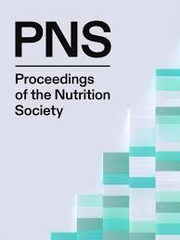No CrossRef data available.
Article contents
Three-year trends in protein intake and grip strength in older adults: an evaluation of an over 60’s exercise programme
Published online by Cambridge University Press: 09 October 2025
Abstract
Over the next four decades, the most substantial population growth is projected to occur among individuals aged 65 and above(1). The ageing process is associated with physiological alterations that adversely affect body systems(2). Evidence supports the recommendation for higher protein intake in older adults to mitigate musculoskeletal deterioration(3). Physical activity programmes offer a valuable means of enhancing physical function in older individuals, providing a strategic setting for delivering interventions for healthy ageing(4). The aim of this investigation was to examine changes in protein intake and handgrip strength over 3 years in a population of adults attending a community exercise programme.
This is a rolling study, recruiting participants from an over 60s exercise class in the North West of the UK. Dietary intake assessed using multiple 24 hour recalls and analysed using Nutritics™ software. Grip strength was assessed using a Takei-5401 digital dynamometer. Grip strength was assessed with participants seated, maintaining a 90- degree angle at the elbow and a neutral forearm position. Mean grip strength was compared to age- and sex-matched 50th centile values(5) using a Wilcoxon Signed-Rank tests. Protein intake (g/d) was compared against calculated recommended amounts based on recommended intakes of 0.75 g/kg bodyweight(6), and higher values of 1.0 g/kg(7) and 1.2 g/kg(8) bodyweight using Wilcoxon Signed-Rank tests.
From a total of 60 participants, 20 individuals participated in year 1, 24 in year 2, and 28 in year 3. Mean grip strength in years 1, 2 and 3 was 19.7 ± 7.1 kg, 21.9 ± 7.6 kg, and 18.6 ± 6.2 kg, respectively, with no significant differences between years (p = 0.242). Mean grip strength in year 3 was significantly lower than the age- and sex-matched values (19.1 ± 7.0 kg vs. 25.0, p < 0.001, respectively). Mean daily protein intake in year 1, year 2 and year 3 was 64.5 ± 31.1 g, 64.9 ± 23.5 g and 63.7 ± 27.6 g, respectively with no significant difference between years (p = 0.472). There was no significant difference between current protein intake and calculated amounts using 0.75 g/kg bodyweight (63.7 ± 27.6 g/d vs. 48.2 ± 6.6 g/d, p = 0.064, respectively). Similarly, current intake did not significantly differ compared to calculated amounts using 1.0 g/kg bodyweight (63.7 ± 27.6 g/d vs. 64.3 ± 8.7, p= 0.469, respectively). Protein intake was significantly below the amount calculated based on 1.2 g/kg bodyweight (63.7 ± 27.6 g/d vs. 77.2 ± 10.5, p = 0.027, respectively).
Grip strength values were significantly below average for participants age and sex, and protein intake is significantly below calculated values for older adults engaging in physical activity. Future initiatives should reinforce the importance of strength training in this group, in addition to improving protein intake.
Information
- Type
- Abstract
- Information
- Proceedings of the Nutrition Society , Volume 84 , Issue OCE4: Nutrition Society Conference 2025, 1-2 July 2025 , August 2025 , E281
- Copyright
- © The Author(s), 2025. Published by Cambridge University Press on behalf of The Nutrition Society


